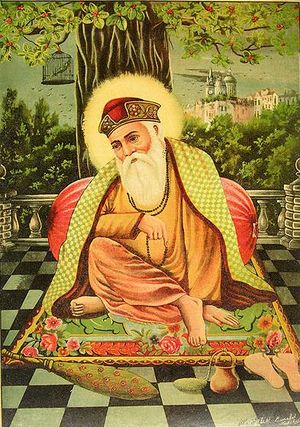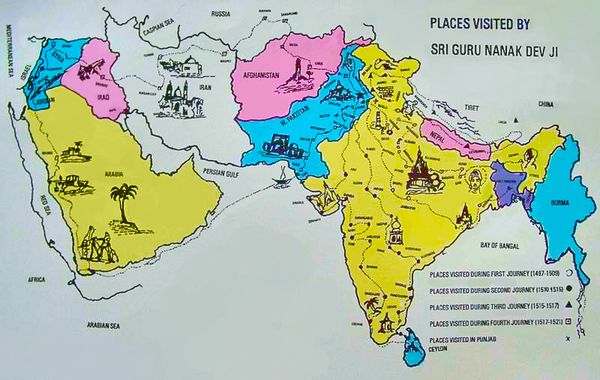Difference between revisions of "Satguru Nanak"
| Line 114: | Line 114: | ||
--> | --> | ||
| − | Bhagat Kabir ji called him Sirdar of Sants<ref>{{cite web |last1=Sitaram |first1=Sunil |title=Guru Nanakdev |url=http://www.kabirchaura.com/ |website=Kabir Chaura Varanasi |publisher=Self published |access-date=28 December 2020}}</ref> | + | Bhagat Kabir ji called him ‘Santon Ka Saradar’ (Sirdar of Sants)<ref>{{cite web |last1=Sitaram |first1=Sunil |title=Guru Nanakdev |url=http://www.kabirchaura.com/ |website=Kabir Chaura Varanasi |publisher=Self published |access-date=28 December 2020 |quote=" Guru Nanakdevji met Kabir saheb in Amar kantak, where the mighty river Narmada rises, and they continued to meet with each-other subsequently. It was Kabir saheb who had designated Guru Nanakdevji as the ‘Santon Ka Saradar’ (the governor of the saints), because Guru Nanakdevji had become the convener-in-chief of the saints’ groups."}}</ref> |
== Gifts == | == Gifts == | ||
Revision as of 16:44, 28 December 2020
Satguru Nanak | |
|---|---|
 | |
| Native name | Sri Guru Nanak Chand ji |
| Successor | Satguru Angad Dev ji |
| Parents |
|
| Gurmat - Beyond Heavens Mindstate |
|---|
 |
(ਸਤਗੁਰੂ ਨਾਨਕ) Satguru Nanak was considered to be God's incarnation on Earth and beyond. Saguru Nanak Chand ji brought oneness to the world in a practical sense with his teachings of the divine truths accessible to all religions, caste, sex, social class.
To challenge social norms Satguru ji wore a Hindu garb tied oddly with a Muslim head apparel. Guru Nanak travelled to places far and wide teaching people the message of one God who dwells in every one of God's creations and constitutes the eternal Truth.[1] He setup a unique spiritual, social, and political platform based on equality, fraternity love, goodness, and virtue.[2][3][4]
After Satguru Nanak Sri Guru Angad ji his most whole heartedly obeying disciple proceeded as the next king and Guru carrying the same embodiment as the previous Guru and considered as Guru Angad was considered as an embodiment of Satguru Nanak himself. Baba ji spent 24 years on the 5 udasis (long travels from home).
Biography
Guru Nanak's Life at Sultanpur
Nanak married Sulkhni of Batala, and they had two sons, Sri Chand and Lakhmi Das. Guru ji's brother-in-law, the husband of his sister Nanki, obtained a job for him in Sultanpur as the manager of the government's grainary.
Udasis
First Udasi (1500-1506 AD)
Satguru Nanank went to Sultanpur, Tulamba (modern Makhdumpur, zila Multan), Panipat, Delhi, Banaras (Varanasi), Nanakmata (zila Nainital, U.P.), Tanda Vanjara (zila Rampur), Kamrup (Assam), Asa Desh (Assam), Saidpur (modern Eminabad, Pakistan), Pasrur (Pakistan), Sialkot (Pakistan). Guru Nanak was of the age of 31-37.
Important events:
- First Stop At Eminabad
- Sujjan Thug
- Guru Nanak At Hardwar
- Guru At Gorakhmata
- Reetha Sahib
- Guru At Banaras
- Guru At Gaya
- Guru To Kamrup
- Kauda Rakhshash
- Guru At Jagan Nath Puri
Second Udasi (1506-1513 AD)
To Dhanasri Valley, Sangladip (Sri Lanka). Guru Nanak was of the age of 37-44
- Discourse With Jains
- Discourse With Majhavars
- Discourse with Kauda Cannibal
- Somnath Temple, Gujrat
- Dwarka, Gujrat
- Recitation of Bani Dakhni Oankar
- Collection of Bhagat Bani
- Guru To Sangladeep (Ceylon)
- Nanak Jhira
- Guru To Sarsa
- To Sultanpur
Third Udasi (1514-1518 AD)
To Kashmir, Sumer Parbat, Nepal, Tashkand, Sikkim, Tibet. Guru Nanak was of the age of 45-49
- Guru Nanak at Sri Nagar
- From Srinagar
- Lake Guru Dongmar
- Gurudwaras in Jammu & Kashmir
- Gurdwara Sri Nanak Mata Sahib
Fourth Udasi (1519-1521 AD)
To Mecca and the Arab, European, African countries.
Guru Nanak was of the age of 50-52
- Multan, Lakhpat, Karachi
- Addan, Jeddah, Al Mecca, Medina
- Baghdad, Basrah, Karbala
- Bushehar, khorramShahr
- Tehran, Ashghabat, urgench, bukhara, Samarkand
- Guru Nanak in Pakpattan
- Kandhar, Kabul, Hassan Abdal, Jalalabad
- Guru Nanak in Mecca, Saudi Arabia
- Guru Nanak in Medina, Saudi Arabia
- Guru Nanak in Jeddah, Saudi Arabia
- Guru Nanak in Turkey, Azerbaizan, Africa & Rome
- Guru Nanak at Messologhi, Greece
- Guru Nanak in the town of Arta, Greece
- Guru Nanak in Kastoria, Greece
- Back at Baghdad
- Mehds
- Kabul
- Guru Nanak at Hassan Abdal
- Guru Nanak at Eminabad
Fifth Udasi (1523-1524 AD)
Happened within places within the Punjab.
Guru Nanak was of the age of 54-56
- Guru At Achal Batala
Stay at Kartarpur
After which he settled to Kartarpur before leaving his physical form (1525-1539 AD). Guru Nanak was of the age of 56-70.
Other names of Baba Ji
As Satguru Nanak traveled to many different places and met with people of different languages he was given many names and different pronouns the more prominent include Wali Hind, Hazrat Guru Nanak, Nanakacharya, Baba Nanak, Baba Nanak Fakir, Hazrat Rab Majid Baba Nanak Faqi, and he was believed to be a reincarnation of the most famous Buddhist Guru Rimpoche in Tibet as Guru Rimpoche Nanak.
Bhagat Kabir ji called him ‘Santon Ka Saradar’ (Sirdar of Sants)[5]
Gifts
Raags in the Guru Granth Sahib
Satguru Nanak has shabds in the following Raags in the SGGS ji: Asa, Basant, Bhaira, Bihaagrhaa, Bilaaval, Dhanasri, Gauri, Goojree, Majh, Maru, Malar, Prabhati, Raamkali, Sarang, Sorath, Suhi, Tilang, Tukhari, Vadhans, Sri Rag.
Further reading
- Guru Nanak Prakash - Kavi Santokh Singh ji (1843 AD)
See also
- Japji Sahib
- Asa Di vaar
- Dakhni Oankar
- Sidh Gosht
- Majh vaar
- Malar vaar
Guru Nanakdevji met Kabir saheb in Amar kantak, where the mighty river Narmada rises, and they continued to meet with each-other subsequently. It was Kabir saheb who had designated Guru Nanakdevji as the ‘Santon Ka Saradar’ (the governor of the saints), because Guru Nanakdevji had become the convener-in-chief of the saints’ groups.<templatestyles src="Module:Citation/CS1/styles.css"></templatestyles>
